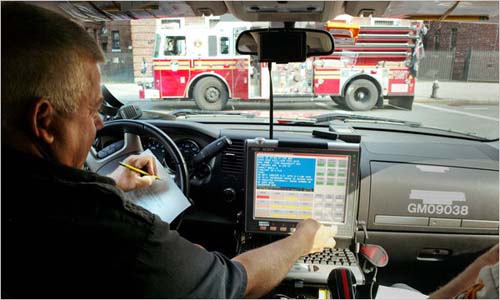
George Jones, a firefighter with the city's 19th Battalion, used the Fire Department's new Electronic Fireground Accountability System to respond to a recent alarm in the Bronx.
For a New York City firefighter in trouble, issuing a “mayday” has always set off a frenzy. It prompts chiefs to shout to try to keep people off the air. As radio silence takes hold, firefighters count heads and try to determine from whom and where the call came.
When multiple maydays come at once, they can cancel each other out, intensifying the chaos and danger.
The Sept. 11 attacks, and other disasters since then, painfully illuminated the difficulty of locating lost firefighters: mayday calls rang out, but it was often difficult to tell who was sending them.
Since then, the Fire Department has been working to develop an accountability system that would more effectively pinpoint the locations of firefighters and equipment and log those spots, Deputy Assistant Chief Stephen Raynis said. The goal of tracking mayday calls more precisely is one of five initiatives the department has undertaken as part of an overall strategy that relies on data to increase awareness and communication in emergencies, when hundreds of people may be converging at once.
Last week, the department began the first citywide use of a new software system, known as the Electronic Fireground Accountability System, that can identify the seven-digit number unique to a radio, the department’s spokesman, Francis X. Gribbon, said. It then translates that number into a firefighter’s name and displays it, if necessary, on the laptop computers mounted in various places, including in fire commanders’ vehicles.
In addition, the software, which cost about $750,000, uses a city wireless Internet connection to reach a database for each fire company’s working tour. This allows it to display not only firefighters’ names, but also their ranks and assignments. If firefighters issue maydays by pressing the emergency alert button on their bunker gear, a red light will flash on the computer, instantly identifying who sent it and saving valuable time, Mr. Gribbon said.
Firefighters are being trained to use these emergency alert buttons rather than speaking if they are in danger, since speaking is not always possible. This way, officers can immediately identify the person who is in need of life-saving equipment.
“We have struggled in the past with who gave the mayday, because it was done verbally,” Mr. Gribbon said. “Now, actually, the software has been developed to link to the radios themselves.”
“This has been 10 years in the making,” the fire commissioner, Salvatore J. Cassano, said. “We’re going from a manual system that depended on the person being able to say, ‘Mayday, mayday, mayday,’ and giving their locations, to now being able to know who transmitted that mayday signal because it will come up on our laptop.”
He added, “It is a huge change in the way we account for people that are in trouble.”
By broadcasting who is in need of help, the new mayday software resolves one difficulty the department faces in such situations. However, another, equally important difficulty remains: determining where the firefighter is with enough precision to get a rescue team headed that way.
The department plans to improve the radio technology so it can identify locations as well as names.
“When technology gets down the road a bit further, we hope to know that the firefighter is on whatever floor of a building he or she is on,” Mr. Gribbon said. “For now, the chief will know we got a mayday, for instance, from our ladder company’s roof man. It is instantaneous feedback.”
Glenn P. Corbett, an associate professor of fire science at John Jay College of Criminal Justice, said, “Anything the Fire Department can do to improve their ability to more quickly locate a trapped firefighter is a significant step forward.”
But he pointed out the limitations of such technology when it comes to locating people in large, three-dimensional buildings — a problem that has been studied for years around the country.
“The ultimate solution would be to have this trapped firefighter on a three-dimensional diagram with an exact location for where he is trapped,” Professor Corbett said. “But we are still a few steps away from that.”
The new mayday system is part of a broader effort, begun by the department in the aftermath of 9/11, to increase awareness of firefighters’ whereabouts in dangerous times and to share that information more quickly during emergencies.
The department is in the process of developing an electronic board that would serve as a sophisticated, automated map to keep track of moving parts, to help incident commanders make decisions and to document moves. The information from that board would be available at headquarters, where chiefs could immediately see and comment on the maneuvers and tactics and send feedback. Later, the whole operation could be stored.
Also in the works are chips with identifying information that would be implanted in firefighters’ bunker gear and would establish traceable electronic records of their movements, as well as a system that would help locate firefighters who became immobilized at emergencies.
The department has already begun to convert companies’ daily rosters of firefighters into an electronic database, an innovation that grew out of 9/11, when such rosters were handwritten.
Mr. Raynis, the deputy assistant chief, said that the department was “on the cusp” of a series of breakthroughs in the way firefighters were tracked to improve their safety, and that the goal was to one day mesh all five initiatives into one system.
Mr. Gribbon said some problems were still being resolved in the approximately 5 percent of the city in which there are dead spots, where the technology is prone to failure. “It’s about 95 percent coverage right now,” he said. “But we are hoping to reach as close to 100 percent as we can.”
By AL BAKER / NYTimes.com
| ![]()




